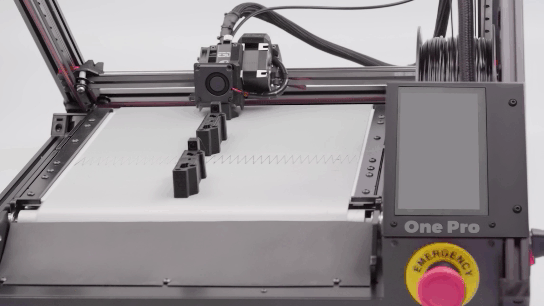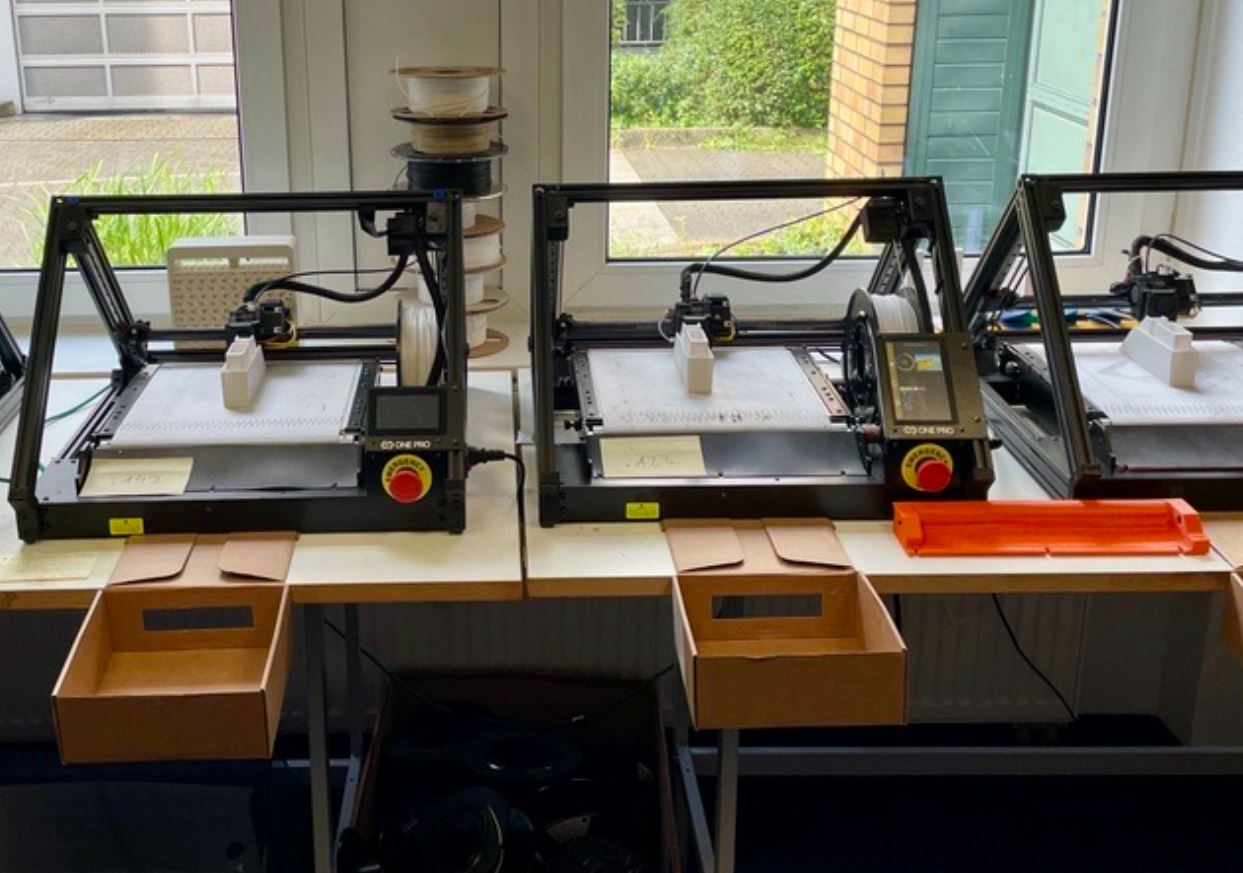Serial printing sounds complex, but don’t let that scare you away! Agile processes and fast workflows are the best foundation for maximizing revenue. In this context, it is advantageous if agility is also reflected in production. For autonomous, fast and uncomplicated production, series production with additive manufacturing processes is becoming increasingly interesting. In this guide, we provide a detailed explanation of how iFactory3D GmbH’s One Pro simplifies series printing and how you can benefit from this pioneering technology.
What is serial printing?
Serial printing allows you to produce identical objects in high volumes without having to perform each step manually over and over again. The One Pro automates this process to make your production more efficient. Batch printing can also be done with Cartesian printers so that, for example, a relatively small object can be placed repeatedly in the available build space to fill the entire print area. These objects are then produced simultaneously. If more parts of the same type are needed, the build space can be manually emptied and cleaned after a print cycle is complete, and a new print cycle can be started. The One Pro, on the other hand, uses a conveyor belt as a printing surface. The belt conveys the parts during the printing process and the finished parts are automatically unloaded.
How does the One Pro work for serial printing?
The One Pro uses its belt system to continuously print parts. You don’t have to manually remove each part – the printer does it automatically. The print area is continuously cleared by the gradual rotation of the print base so that new prints can be started. This way, you can effortlessly produce large quantities of parts. With the One Pro, however, series printing is not limited to identical parts. If you need objects with different geometries made from the same material, iFactory3D’s 3D conveyor belt printer is just as suitable. The printing system offers a queuing function, so you can finish 3D models and print them directly afterwards, while the One Pro is still busy with a predecessor. This is handy, for example, to create iterations to be compared directly. The only differences are in the shape; the external circumstances remain largely comparable in the ongoing printing process.
Applications in various industries
Manufacturing:
The One Pro is revolutionizing the production of parts. Whether in the automotive industry or in mechanical engineering, series printing saves time and money. It can be used in end-product manufacturing as well as for the production of specific auxiliaries and tools.
Advertising:
Personalized promotional materials can be produced effortlessly in large quantities. Gifts for trade shows can be produced promptly in the desired quantity specific to the trade show and target group. And depending on the model, they can even be produced at a much lower cost than the typical pens or notebooks.
Medical:
The One Pro optimizes the production of medical products. The additive manufacturing process is ideal for medical devices, some of which are highly individualized, such as orthotics or orthopedic insoles. Thanks to the conveyor belt function, the products can be manufactured permanently to supply as many patients as possible. And the unlimited print length, also due to the conveyor belt, means that braces or splints for legs, for example, can be manufactured in one piece, which makes the products particularly stable.
Step-by-step instructions for serial printing with the One Pro:
Preparation:
You have several options when doing series printing with the One Pro: a) Create the model you want to duplicate and load it into the One Pro. Use the loop function in the printer control. b) Load the different cut 3D models into the printer via WLAN or USB connection, select all of them and use the queue function. c) Load all objects to be printed as STL file, DXF file or similar into the slicer and place them one after the other. Slice them together and create a single G-code for the object sequence.
Automation:
Place enough material in the printer. For large jobs, choose appropriately sized filament rolls. But don’t worry: If material runs out while an object is being produced, printing stops automatically. You can refill material, and when you restart printing, the printer will pick up exactly where it left off. This way, you don’t lose any progress and therefore no material. Apart from that, you can now relax. The One Pro will take care of the rest.
Continuous printing:
Parts are automatically printed and taken off the belt as new parts are created. For small objects, for example, provide a box into which the finished parts can fall. For long objects, you can use the suiting modular print bed extension. This ensures a smooth flow with the rollers so that there are no errors caused by jams in the printing area.
Quality Control:
Monitor the first pass of the desired object each time. It is important that the temperature of the nozzle and the print bed harmonize with the selected material. The print height should also always be checked to ensure optimum adhesion between the belt and the object. This prevents layer shifts or air printing, and warping or the spaghetti chaos infamous among 3D printing connoisseurs can also be avoided with good bed leveling. The One Pro helps with the correct print height with its automatic bed leveling assistant. Once the first print is done to satisfaction, you can sit back and relax: The next parts will be printed in the same quality.
Post-processing:
If desired, perform final post-processing steps. Fortunately, the amount of post-processing needed is very small on the One Pro. Since the 45° angle allows printing directly onto the object with sufficient adhesion, support structures can largely be dispensed with. Of course, these then do not have to be removed afterwards either. This saves valuable time, because detaching the support and evening out the surface requires a sure touch and patience if a flawless result is to be achieved.
The ” Serial Printing for Dummies” guide shows you how the One Pro can streamline your manufacturing processes. Whether you’re in the automotive industry, engineering, or something else entirely, the One Pro offers everyone an innovative solution for efficient, high-quality series printing.
 Serial production
Serial production
